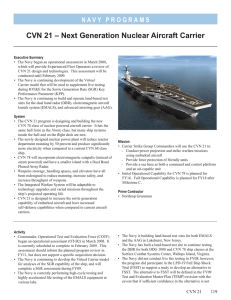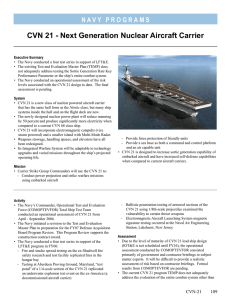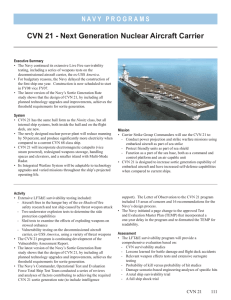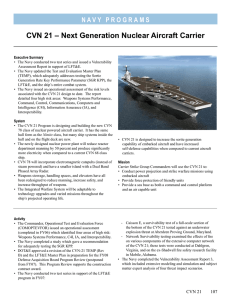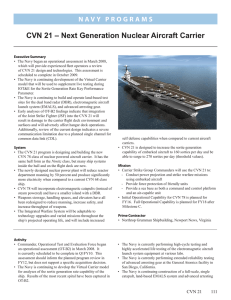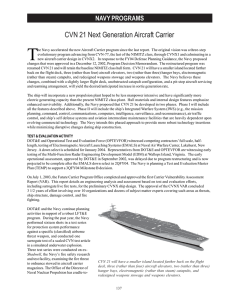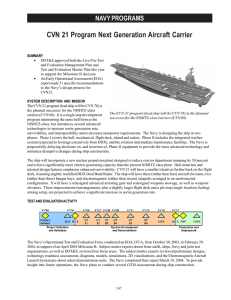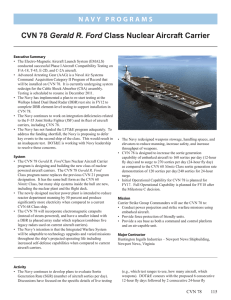Gerald R. Ford
advertisement
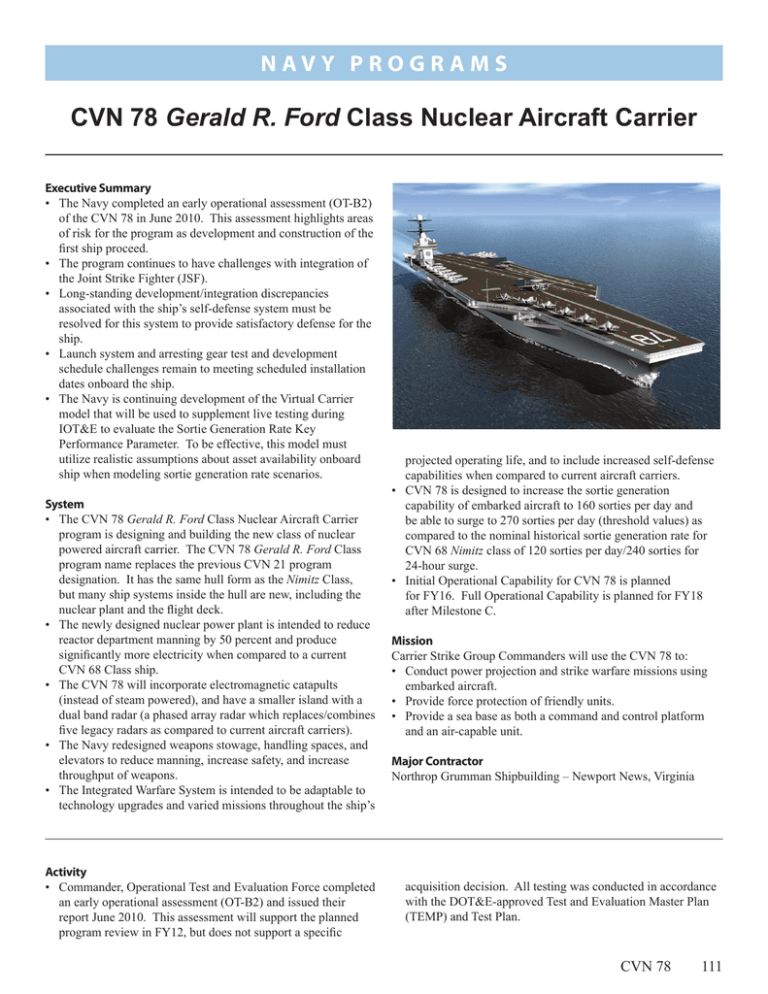
N a v y P ROGRAMS CVN 78 Gerald R. Ford Class Nuclear Aircraft Carrier Executive Summary • The Navy completed an early operational assessment (OT-B2) of the CVN 78 in June 2010. This assessment highlights areas of risk for the program as development and construction of the first ship proceed. • The program continues to have challenges with integration of the Joint Strike Fighter (JSF). • Long-standing development/integration discrepancies associated with the ship’s self-defense system must be resolved for this system to provide satisfactory defense for the ship. • Launch system and arresting gear test and development schedule challenges remain to meeting scheduled installation dates onboard the ship. • The Navy is continuing development of the Virtual Carrier model that will be used to supplement live testing during IOT&E to evaluate the Sortie Generation Rate Key Performance Parameter. To be effective, this model must utilize realistic assumptions about asset availability onboard ship when modeling sortie generation rate scenarios. System • The CVN 78 Gerald R. Ford Class Nuclear Aircraft Carrier program is designing and building the new class of nuclear powered aircraft carrier. The CVN 78 Gerald R. Ford Class program name replaces the previous CVN 21 program designation. It has the same hull form as the Nimitz Class, but many ship systems inside the hull are new, including the nuclear plant and the flight deck. • The newly designed nuclear power plant is intended to reduce reactor department manning by 50 percent and produce significantly more electricity when compared to a current CVN 68 Class ship. • The CVN 78 will incorporate electromagnetic catapults (instead of steam powered), and have a smaller island with a dual band radar (a phased array radar which replaces/combines five legacy radars as compared to current aircraft carriers). • The Navy redesigned weapons stowage, handling spaces, and elevators to reduce manning, increase safety, and increase throughput of weapons. • The Integrated Warfare System is intended to be adaptable to technology upgrades and varied missions throughout the ship’s Activity • Commander, Operational Test and Evaluation Force completed an early operational assessment (OT-B2) and issued their report June 2010. This assessment will support the planned program review in FY12, but does not support a specific projected operating life, and to include increased self-defense capabilities when compared to current aircraft carriers. • CVN 78 is designed to increase the sortie generation capability of embarked aircraft to 160 sorties per day and be able to surge to 270 sorties per day (threshold values) as compared to the nominal historical sortie generation rate for CVN 68 Nimitz class of 120 sorties per day/240 sorties for 24-hour surge. • Initial Operational Capability for CVN 78 is planned for FY16. Full Operational Capability is planned for FY18 after Milestone C. Mission Carrier Strike Group Commanders will use the CVN 78 to: • Conduct power projection and strike warfare missions using embarked aircraft. • Provide force protection of friendly units. • Provide a sea base as both a command and control platform and an air-capable unit. Major Contractor Northrop Grumman Shipbuilding – Newport News, Virginia acquisition decision. All testing was conducted in accordance with the DOT&E-approved Test and Evaluation Master Plan (TEMP) and Test Plan. CVN 78 111 N a v y P ROGRAMS • The Navy is continuing to develop the Virtual Carrier model for analysis of the sortie generation rate (SGR) capability of the ship. Spiral 8 model results were captured in OT-B2. Seventeen spirals are planned. • The Navy commissioned the Electromagnetic Aircraft Launch System (EMALS) System Functional Design (SFD) test site in September 2010 and is performing EMALS testing with no-load and dead loads at Joint Base McGuire-Dix-Lakehurst, New Jersey. • The Navy is performing testing of the advanced arresting gear (AAG) on a jet car track at Joint Base McGuire‑Dix‑Lakehurst, New Jersey. • The Navy completed initial testing of the Dual Band Radar (DBR) system at the Surface Combat Systems Center in Wallops Island, Virginia. The Navy is assessing the test data to determine if further DBR testing will be necessary in FY12. • The Navy has taken action on upgrading the single transmit/ receive channel for Common Data Link (CDL) used for tactical information exchange between the ship and embarked aircraft. The Navy has designed a four-channel system for installation in CVN 79 and retrofit to CVN 78 post-delivery. • The CVN 78 Gerald R. Ford Class Carrier Program Office is revising the TEMP in an effort to align planned developmental test with corresponding operational test phases. • The Navy continues to develop an alternative approach to conducting the Full Ship Shock Trial (FSST). The Navy will conduct a traditional FSST if the alternative approach is not technically feasible or costs more than $65 million. Assessment • The Navy began CVN 78 construction in 2008 and plans to deliver the ship in September 2015. Current progress supports this plan, but the EMALS/AAG, DBR, and Integrated Warfare System are significant risk areas. • The CVN 78 program continues to have challenges with F-35 Joint Strike Fighter (JSF) integration. The thermal footprint from the main engine exhaust, shipboard noise levels, and information technology requirements need work. Design changes may be required for the jet blast deflectors, and active cooling may be required in the flight deck just forward of the jet blast deflector. • As a cost-saving measure, an adjustment to the DDG-1000 ship program in 2010 eliminated the volume search radar (VSR) component of the DBR, leaving only multi-function radar; however, the DBR test plan remained unchanged, with the DDG-1000 program responsible for all DBR developmental testing. CVN 78 plans to leverage the DDG‑1000 DBR test data as a means of conserving resources. The DDG-1000 DBR test program concluded testing in September 2010 and has temporarily closed the DBR test site at Wallops Island Engineering Test Center. The Navy plans to re-open the site in FY12 and is assessing the completeness of the DBR test data from initial testing. The Navy will conduct 112 CVN 78 • • • • any follow-on DBR testing in FY12 after re-opening the DBR test site. Significant additional DBR testing will likely result in cost growth and DBR test completion delays for the CVN 78 program. Numerous integrated warfare system items are of concern, including: - The ship self-defense combat systems on aircraft carriers have historically had reliability and weapon system integration shortcomings. While the Navy has made efforts, it has not yet developed a detailed plan to address these concerns on CVN 78. - The Navy lags in developing a new anti-ship ballistic missile target and in obtaining a capability to launch four simultaneous supersonic sea-skimming targets. Both are required to assess effectiveness of ship self-defense. - Cooperative Engagement Capability (CEC) is in the CVN 78 warfare system baseline. DBR will be capable of providing fire-control quality, high data rate information for relay by CEC. Future Aegis upgrades may allow Aegis ships to use fire-control data from CVN 78. However, it is not clear whether the Navy will implement this capability on CVN 78 and what impact it may have on the integrated warfare system test planning and the CVN 78 primary mission. - CVN 78 will continuously and simultaneously use DBR for both air traffic control and warfare, whereas separate legacy systems perform these missions individually. Merging these previously separate missions into a single system requires significant testing and integration. Testing is currently scheduled shipboard pier-side, instead of making more complete use of the land-based Wallops Island facility; this complicates the test-fix-test timeline. The current state of the Virtual Carrier model does not fully provide for an accurate accounting of SGR due to a lack of fidelity regarding manning, equipment availability, and weather conditions. EMALS experienced two notable hardware/software incidents that caused test delays at the SFD test site in Lakehurst. One incident involved an un-commanded armature retraction due to a software anomaly in the asset protection module. The second anomaly involved the loss of an encoder from the catapult armature during a dead-load test. Both anomalies have been resolved. EMALS has started performance verification testing with dead loads at the SFD site, and AAG is nearing the start of Jet Car Track Site dead load testing. Required In Yard Date (RIYD) for these systems continues to drive the development schedule; however, to date development and testing remains on track. The alternative Full Ship Shock Trial (FSST) method offers potential for utilizing advanced finite element modeling and simulation to augment live testing. This will require significant time and financial resources to conduct an appropriate validation, verification, and accreditation (VV&A). N a v y P ROGRAMS Recommendations • Status of Previous Recommendations. The Navy satisfactorily addressed all FY09 recommendations. • FY10 Recommendations. The Navy should: 1. Resolve integration challenges with JSF. 2. Finalize plans that address CVN 78 integrated warfare system engineering and ship’s self-defense system discrepancies. 3. Develop and procure an anti-ship ballistic missile target, and pursue range upgrades to allow up to four supersonic sea-skimming targets to be launched simultaneously. 4. Continue the work of the SGR Test Strategy Integrated Product Team to develop a realistic model for determining the sortie generation rate while utilizing realistic assumptions regarding equipment availability, manning, and weather conditions. 5. Identify contingency timelines for EMALS/AAG systems to permit more flexibility and mitigate schedule risk in the development of those systems. 6. Ensure adequate VV&A of FSST modeling and simulation prior to any final decisions on FSST alternatives. CVN 78 113 N a v y P ROGRAMS 114
